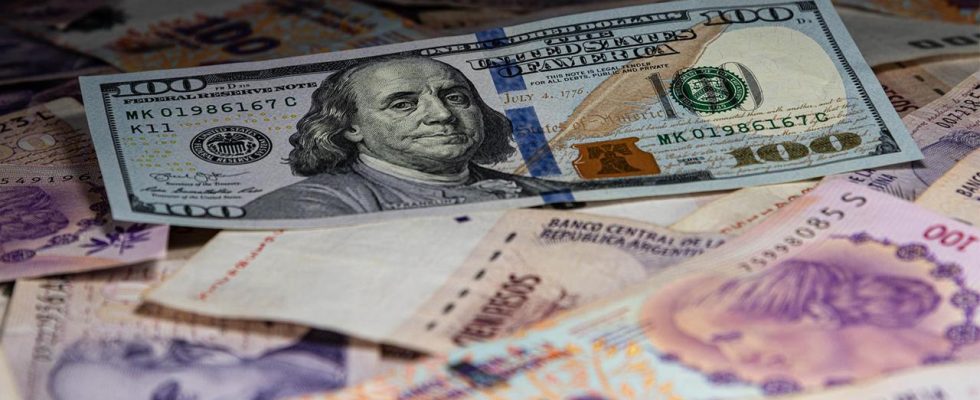analysis
The self-proclaimed anarcho-capitalist Javier Milei aims to dollarize Argentina. That sounds crazy – and yet it could be the second best solution for the country.
The peso isn’t even used to “clean up excrement”: Javier Milei aggressively defended this opinion during the election campaign. The right-wing populist aims for the complete dollarization of Argentina – including the abolition of the central bank. After his victory in the runoff election for the presidency, the radical plan to introduce the US currency could now possibly become a reality. But is that really such a good idea?
Official inflation rate at 143 percent
The fact is: Inflation in Argentina is among the highest in the world. It was only in October that the inflation rate rose to a record high of almost 143 percent; a year earlier it had been 88 percent. There is no end in sight to the upward trend in consumer prices.
The rise in inflation is being fueled by the rapid devaluation of the Argentine peso: the domestic currency has been in free fall against the dollar since the government devalued it by almost 18 percent in mid-August. The official rate is 350 pesos, which must be paid for one dollar, while the black market rate (“Dollar Blue”) has temporarily risen to over 1,000 pesos. The peso crash in turn increases imported inflation – a vicious circle.
Expert: Dollarization in Argentina “easier than elsewhere”
Abolishing the peso and introducing the dollar as a replacement for the national currency would break this cycle; South America’s second largest economy would have a real chance of getting back under control of inflation. Dollarization in Argentina is likely to be “easier than elsewhere.” At least this is the conclusion reached by Ulrich Leuchtmann, foreign exchange expert at Commerzbank. He points to the central bank’s supply of 7.7 trillion pesos and the dollar reserves of 21.5 billion. The central bank could thus service its claims at a dollar-peso rate of around 360 – not far from current exchange rates.
“The opening dollar balance of the commercial banks would therefore hardly be affected, and the cash holdings of companies and households would hardly see any loss in value,” explains Leuchtmann. Even the final burst of inflation that is usual and sometimes severe with dollarization would no longer occur. “A dollarization of Argentina would be quite close to a currency conversion (…) and would therefore be less disruptive than dollarization is often portrayed in textbooks.”
At the mercy of the Fed
The usual “practical” problems with dollarization therefore appear to be manageable in the case of Argentina. However, things may look different when it comes to monetary policy. With the dollar, Argentines are not only buying a more stable currency, but also a currency whose fortunes are controlled by a central bank located in another country. With the introduction of the dollar and the logical abolition of its own central bank, Argentina would be at the mercy of the US Federal Reserve.
To put it concretely: The Fed has most likely reached the interest rate peak. The markets are already pricing in the first interest rate cuts from May. But it is at least questionable whether an interest rate level of currently 5.25 to 5.5 percent and soon interest rate cuts are really what an economy like Argentina needs at the moment. In any case, the Fed’s monetary policy would also have a direct impact on the Argentine economy in the future – without it being expected that the US monetary authorities will give a single second’s attention to this when making their decisions.
40 percent of Argentines live in poverty
So is dollarization really the method of choice to get Argentina’s economic problems under control, as the self-proclaimed anarcho-capitalist Milei suggests? Economic textbooks contain completely different recommendations for a country as large as Argentina that is hit by inflation: raising interest rates, reducing bond purchases, reducing the money supply.
In reality, Argentines do not live in such an ideal world. Instead, they can watch as their currency loses value by the minute. The rise in prices is depleting wages and savings, and two out of five Argentines live below the poverty line.
Money printing machines run around the clock
The Argentine central bank has increased interest rates sharply – most recently in October. The key interest rate is currently 133 percent. But according to experts, it was always too late with its interest rate increases. It has therefore fallen “behind the curve”, i.e. inflation expectations are out of control. However, in such a situation, higher interest rate increases are still required to bring inflation back under control. The flight out of the peso and into the dollar is virtually unstoppable.
In addition, the massive subsidies that Argentina has been granting its residents for decades have led to a massive budget deficit. To finance it, the central bank is constantly printing huge amounts of fresh money. But that only fuels inflation even further.
Second best solution as an alternative for Argentina?
There is no question: an economically sensible self-managed currency and its own central bank committed to currency stability would actually be the best choice for a country the size of Argentina. But Argentina’s institutions have failed in this regard – and have done so for decades. The Argentine population suffers. So maybe it really is time to consider the second best solution.

